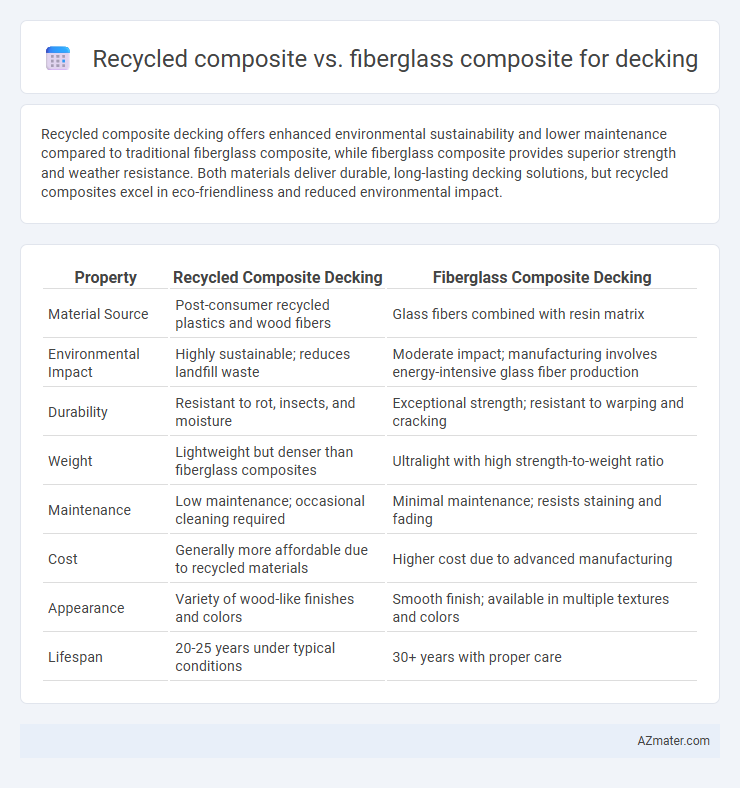Recycled composite decking offers enhanced environmental sustainability and lower maintenance compared to traditional fiberglass composite, while fiberglass composite provides superior strength and weather resistance. Both materials deliver durable, long-lasting decking solutions, but recycled composites excel in eco-friendliness and reduced environmental impact.
Table of Comparison
| Property | Recycled Composite Decking | Fiberglass Composite Decking |
|---|---|---|
| Material Source | Post-consumer recycled plastics and wood fibers | Glass fibers combined with resin matrix |
| Environmental Impact | Highly sustainable; reduces landfill waste | Moderate impact; manufacturing involves energy-intensive glass fiber production |
| Durability | Resistant to rot, insects, and moisture | Exceptional strength; resistant to warping and cracking |
| Weight | Lightweight but denser than fiberglass composites | Ultralight with high strength-to-weight ratio |
| Maintenance | Low maintenance; occasional cleaning required | Minimal maintenance; resists staining and fading |
| Cost | Generally more affordable due to recycled materials | Higher cost due to advanced manufacturing |
| Appearance | Variety of wood-like finishes and colors | Smooth finish; available in multiple textures and colors |
| Lifespan | 20-25 years under typical conditions | 30+ years with proper care |
Introduction to Composite Decking Materials
Composite decking materials consist primarily of recycled composites and fiberglass composites, both engineered to enhance durability and reduce maintenance compared to traditional wood decking. Recycled composite decking incorporates reclaimed wood fibers and recycled plastics, offering an eco-friendly option with resistance to fading, staining, and moisture. Fiberglass composite decking features a high-strength fiberglass shell over a polypropylene core, providing exceptional resistance to mold, mildew, and structural deformities.
What Are Recycled Composite Decking Boards?
Recycled composite decking boards are made from a blend of reclaimed wood fibers and recycled plastics, offering an eco-friendly alternative to traditional materials. These boards provide enhanced durability, resistance to rot, insects, and fading compared to fiberglass composites, which are primarily glass fiber reinforced polymers known for high strength but less environmental sustainability. Incorporating recycled materials reduces landfill waste and lowers the carbon footprint associated with decking production while maintaining aesthetic appeal and structural integrity.
Defining Fiberglass Composite Decking
Fiberglass composite decking consists of a durable material made from glass fibers embedded in a resin matrix, offering high strength and resistance to warping, fading, and moisture damage. Its non-porous surface prevents mold and mildew growth, providing long-lasting structural integrity and low maintenance. Compared to recycled composites, fiberglass composites excel in lightweight properties and superior load-bearing capacity, making them ideal for heavy-use outdoor decking applications.
Environmental Impact: Recycled vs Fiberglass Composites
Recycled composite decking significantly reduces environmental impact by repurposing waste materials such as plastic and wood fibers, lowering landfill waste and conserving natural resources. Fiberglass composites, while durable, often rely on non-renewable raw materials and have a higher carbon footprint due to energy-intensive manufacturing processes. Choosing recycled composites supports sustainability initiatives by minimizing pollution and promoting circular economy principles in decking materials.
Durability and Longevity Comparison
Recycled composite decking typically offers enhanced durability due to its UV resistance and moisture-repellent properties, reducing warping and fading over time compared to traditional fiberglass composite. Fiberglass composite decking excels in strength and impact resistance, maintaining structural integrity under heavy loads but may suffer from surface cracking or discoloration with prolonged exposure. Both materials provide long lifespans, yet recycled composites often demonstrate superior resistance to environmental wear, extending decking longevity in diverse outdoor conditions.
Maintenance Requirements for Both Materials
Recycled composite decking requires minimal maintenance, needing only occasional cleaning with soap and water to prevent mold and mildew buildup, with no sanding, staining, or sealing necessary. Fiberglass composite decking demands more regular upkeep, including periodic cleaning and inspection for surface cracks or splinters to maintain its appearance and structural integrity. The low maintenance demands of recycled composites make them a cost-effective and durable option compared to the more labor-intensive care needed for fiberglass composites.
Cost Analysis: Recycled Composite vs Fiberglass Composite
Recycled composite decking typically costs between $4 to $7 per square foot, offering a lower initial investment compared to fiberglass composite, which ranges from $8 to $12 per square foot. The maintenance expenses for recycled composites are minimal due to their resistance to rot and staining, while fiberglass composites, though more expensive upfront, provide superior durability and require less frequent replacement over time. When evaluating total life-cycle costs, recycled composites are cost-effective for budget-conscious projects, whereas fiberglass composites deliver long-term savings through enhanced strength and longevity.
Aesthetic Options and Customization
Recycled composite decking offers a wide range of color blends and textured finishes that mimic natural wood, providing eco-friendly aesthetic options with minimal maintenance. Fiberglass composite decking boasts superior customization capabilities, allowing for precise color matching, custom shapes, and intricate designs due to its versatile molding process. Both materials enhance outdoor spaces, but fiberglass excels in tailored design choices while recycled composite emphasizes sustainability with attractive, natural-looking styles.
Safety and Performance in Outdoor Environments
Recycled composite decking offers enhanced safety features with its slip-resistant surface and reduced risk of splintering compared to traditional fiberglass composite. Performance in outdoor environments favors recycled composites due to their superior resistance to moisture, UV rays, and temperature fluctuations, minimizing warping and fading over time. Fiberglass composites, while durable, may not match the eco-friendly benefits and improved traction of recycled composites, making the latter a safer and more sustainable choice for outdoor decking applications.
Choosing the Best Composite for Your Decking Project
Recycled composite decking offers superior environmental benefits by utilizing post-consumer materials, reducing landfill waste, and often incorporating UV-resistant coatings for enhanced durability. Fiberglass composite decking provides exceptional strength-to-weight ratio and resistance to warping, moisture, and temperature fluctuations, making it ideal for high-traffic or extreme weather environments. Choosing the best composite depends on your priorities for sustainability, maintenance needs, and the specific climate conditions of your decking location.

Infographic: Recycled composite vs Fiberglass composite for Decking
 azmater.com
azmater.com